Atlantis: The Lost Empire appears in an aspect ratio of approximately 2.35:1 on this single-sided, dual-layered DVD; the image has been enhanced for 16X9 televisions. Ever since A Bug’s Life in 1999, Disney has maintained a very high standard for their transfers of recent animated flicks, and Atlantis continued that tradition with another excellent picture.
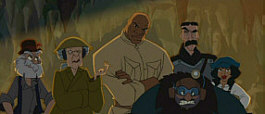 Sharpness looked terrific at virtually all times. The image consistently appeared crisp and distinct even in wide shows, and I detected no concerns related to softness or fuzziness. The clarity wasn’t quite as strong as with DVDs like Toy Story 2, but it remained solid nonetheless. I saw no concerns related to jagged edges or moiré effects, and the movie betrayed absolutely no signs of print flaws. I believe this was another digital-to-digital transfer, which meant it never existed on celluloid. Artifacts seemed absent as well.
Sharpness looked terrific at virtually all times. The image consistently appeared crisp and distinct even in wide shows, and I detected no concerns related to softness or fuzziness. The clarity wasn’t quite as strong as with DVDs like Toy Story 2, but it remained solid nonetheless. I saw no concerns related to jagged edges or moiré effects, and the movie betrayed absolutely no signs of print flaws. I believe this was another digital-to-digital transfer, which meant it never existed on celluloid. Artifacts seemed absent as well.
Colors looked absolutely fantastic throughout the movie. From the cool blues associated with Atlantis to the vivid reds of the lava at the end to a myriad of other tones, the hues came across as tight and vibrant, with absolutely no concerns on display. Black levels also appeared deep and dense, while shadow detail looked appropriately heavy but not excessively thick. Overall, Atlantis provided a very strong picture.
On this DVD, we found both Dolby Digital 5.1 and DTS 5.1 soundtracks for Atlantis. Lately I haven’t heard much difference between mixes found on this kind of dual-audio presentation, but Atlantis offered an exception. I preferred the DTS track to a moderate degree. As such, my comments will address what I heard in it, and I’ll sum up my perceived differences once I finish that.
Atlantis provided a consistently lively and engaging soundfield. We don’t usually find a movie that starts with a demo-worthy sequence, but that occurred here, as the loss of Atlantis kicked off the movie with a genuine bang. It set the stage for the excellent audio that would follow. All five channels received a fine workout, as they usually included some sort of useful information. Of course, during quieter scenes, the forward speakers dominated, but not to the exclusion of the rears; they still contributed realistic ambience.
All of this combined into a very smooth and well-blended package. Music showed solid stereo imaging and presence, and the surrounds added a nice layer of reinforcement to the score. Effects seemed very accurately placed and they moved about the environment with nice fluidity and clarity. Some reviewers have complained that the movie started and ended with vibrant audio but seemed lackluster in between, but I disagree. I thought Atlantis provided an active and involving mix from start to finish; just because things aren’t blowing up doesn’t mean the sound can’t be just as engrossing, and the movie provided a terrific soundfield at all times.
 Audio quality also seemed excellent. Dialogue remained consistently natural and warm, with no problems related to intelligibility or edginess. Speech was integrated cleanly with the other pieces and fit into the package well. Music sounded vivid and bright, and the score displayed solid range. Low-end response was deep and rich without any signs of boominess. Effects also displayed terrific fidelity. They came across as clear and distinct at all times, and they packed a serious punch when appropriate. Bass response worked tremendously well, as it was powerful and distinct, but without the excessive thump heard in films like The Musketeer. Ultimately, the audio offered an excellent experience.
Audio quality also seemed excellent. Dialogue remained consistently natural and warm, with no problems related to intelligibility or edginess. Speech was integrated cleanly with the other pieces and fit into the package well. Music sounded vivid and bright, and the score displayed solid range. Low-end response was deep and rich without any signs of boominess. Effects also displayed terrific fidelity. They came across as clear and distinct at all times, and they packed a serious punch when appropriate. Bass response worked tremendously well, as it was powerful and distinct, but without the excessive thump heard in films like The Musketeer. Ultimately, the audio offered an excellent experience.
So how did the DTS and Dolby Digital tracks differ? Overall, I thought the DTS version sounded smoother and more vibrant. Bass response appeared tighter and more natural, while the elements combined together to create a more seamless and better-integrated package. The differences weren’t enormous, as the DD edition still provided a very good experience. However, I thought they were substantial enough to warrant a distinction in grades; the Dolby track got an “A-“ while the DTS one merited a full “A”.
Fans can choose from two versions of the Atlantis DVD. The “standard” release actually offers something unavailable on the Collector’s Edition: a fullframe transfer of the film. This may be a problem for some people, but personally, I won’t miss the butchered image; a 1.33:1 cropping of this flick would alter it badly.
Otherwise, all of the basic package’s materials make the cut here. Though clearly the special edition offers the more substantial set, the standard release includes a reasonable amount of extras as well; unlike the single-disc versions of A Bug’s Life or Toy Story, it provides some decent stuff. I’ll note anything that appears on both discs with as asterisk; it no such notation shows up, that means the feature is exclusive to the Collector’s Edition.
First up we find an *Audio Commentary with producer Don Hahn and directors Kirk Wise and Gary Trousdale. All three were recorded together for this running, screen-specific track. The men have worked together for years, and that easy camaraderie comes through in this very compelling and entertaining piece.
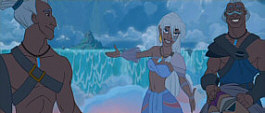 From start to finish, the participants provide an excellent look at the film. They cover the origins of the project, the many alterations that occurred during production, aspects of working with the actors and the composer, and about a million other topics. They even point out the one scene in which they needed to use a sound-alike actor to voice some of Cookie’s lines. The pace remains quick and they keep up a jovial and engaging tone. It’s a terrific track that offers a lot of worthwhile information.
From start to finish, the participants provide an excellent look at the film. They cover the origins of the project, the many alterations that occurred during production, aspects of working with the actors and the composer, and about a million other topics. They even point out the one scene in which they needed to use a sound-alike actor to voice some of Cookie’s lines. The pace remains quick and they keep up a jovial and engaging tone. It’s a terrific track that offers a lot of worthwhile information.
In addition to this audio track, we also find a Visual Commentary. Disney isn’t the first company to attempt this kind of feature. From the crude MST3K stylings of the silhouettes found on Ghostbusters and Men In Black to the simple video snippets of The Goonies and Roots, the video commentaries all shared one element: they offered little you couldn’t get from the standard audio track. Oh, it was fun to see the participants interact visually to a certain degree, especially during Goonies or some of the pieces found on Kevin Smith flicks. However, the information remained exactly the same; you didn’t learn anything new if you watched the video.
That changes with Atlantis. Here’s how it works: with this feature activated, eleven times during the film, the movie will branch off to video segments with Hahn, Wise, and Trousdale. When the pieces complete, you return to the flick right where you’d left.
These snippets last between 31 seconds and four minutes, 32 seconds for a total of 23 minutes and 12 seconds of footage. We don’t just watch the three men as they talk. Instead, they offer a mix of elements. We get storyreels for three deleted scenes - none of which appear in DVD Two’s package of unused segments, by the way - plus outtakes and a hidden joke, images from two research trips, and a few other pieces. Some of this expands on information included in the audio commentary, and much of it also appears on DVD Two of this package. Nonetheless, it’s a nice addition to the set that I thought added some useful material and did so in a friendly manner.
Speaking of that, the visual commentary appears in a very user-friendly manner. If you want to see those segments, you don’t have to sit through the whole movie. Instead, the disc offers a “features index”. This displays all 11 pieces. You can choose from any of them or elect to “Play All”. This won’t let you see the 42-second introduction from the three participants that precedes the film when the commentary’s activated, but it’s definitely the most efficient way to check out the components.
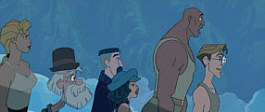 Next we find the *Disneypedia which covers “Atlantis: Fact or Fiction”. This narrated program shows lots of clips from the movie as well as a few images of appropriate things like a bust of Plato and a shot of hieroglyphics. It goes through six topics: “Atlantis”, “Ancient Writings”, “Submarines”, “Archaeology”, “Legends”, and “Ancient Civilizations”. Each of these offers a brief, kid-oriented look at their subjects in this six-minute, 35-second piece. The narrator’s “gee-whiz” tone got annoying, but these clips offer a decent little introduction to their various subjects; they’re very short, so they lack depth, but they could give kids the basis to become more interested in the areas.
Next we find the *Disneypedia which covers “Atlantis: Fact or Fiction”. This narrated program shows lots of clips from the movie as well as a few images of appropriate things like a bust of Plato and a shot of hieroglyphics. It goes through six topics: “Atlantis”, “Ancient Writings”, “Submarines”, “Archaeology”, “Legends”, and “Ancient Civilizations”. Each of these offers a brief, kid-oriented look at their subjects in this six-minute, 35-second piece. The narrator’s “gee-whiz” tone got annoying, but these clips offer a decent little introduction to their various subjects; they’re very short, so they lack depth, but they could give kids the basis to become more interested in the areas.
Lastly, DVD One includes the *THX Optimizer. Also found on DVDs such as The Phantom Menace and as Tron, it purports to help you set up your home theater to best present the movie on the disc in question. Apparently the Optimizer is unique for each DVD on which it’s included; unlike programs such as Video Essentials, the Optimizer should tweak your set-up differently every time. Frankly, I’ve been very happy with my already-established calibration and I’m afraid to muck with it, so I’ve never tried the Optimizer. If you lack calibration from Video Essentials or a similar program, or if you’re just more adventurous than I, the Optimizer could be a helpful addition.
When you start the DVD, you’ll find *ads for some other Disney flicks. There’s a promo for the hotly anticipated DVD video release of Beauty and the Beast; interesting, the ad touts it as “The Special Edition”, not as part of their “Platinum Edition” line. I don’t know if this means they’ve abandoned the term “Platinum Edition” after one release (Snow White and the Seven Dwarfs), but as long as the quality remains high, they can call it the “Piece of Junk” edition for all I care. The trailer highlights the inclusion of “Human Again”, the song added for the IMAX theatrical release of Beauty.
In addition, the DVD opens with promos for Cinderella II: Dreams Come True as well as the Disney DVD collection in general. These clips also can be found in the Sneak Peeks area alongside additional ads for Tron, Schoolhouse Rock, The Hunchback of Notre Dame II, and 101 Dalmatians 2.
Finally, Disc One includes some DVD-ROM content, but not much. All we find are some Weblinks. You can “register” your DVD, which then qualifies you for Disney’s disc replacement program. You can also enter a sweepstakes - when they offer one, that is, for currently (February 1, 2002) they’re running none. This section offers connections to “Disney’s Movie Finder” - a page that offers information about pretty much every Disney flick ever - as well as go to the Disney DVD site. It’s a pretty blah collection of links.
 As we move to DVD Two, we find a wealth of extras. The disc starts with a goofy introduction to the program. We see a three-minute piece presented in the style of a newsreel. It’s anachronistic - supposedly from 1914, it features sound - but it’s a cute and fun way to start the set. (Yes, I’m picking nits.)
As we move to DVD Two, we find a wealth of extras. The disc starts with a goofy introduction to the program. We see a three-minute piece presented in the style of a newsreel. It’s anachronistic - supposedly from 1914, it features sound - but it’s a cute and fun way to start the set. (Yes, I’m picking nits.)
From there we find three different ways to investigate the DVD’s extras. Both the “Explore Mode” and the “File Mode” offer the same information; they just do so in different ways. They allow you to check out all of the materials, but the “Explore Mode” uses a graphic interface based on the movie’s sub, whereas “File Mode” simply presents text listings of the features grouped together by topic. I chose the latter since the graphics slow down access to extras, but I liked the inclusion of the flashier method as well.
The other option won’t provide everything available on the DVD, but it’s a very user-friendly way to go through much of it. The “Tour Mode” takes all eleven of the video segments found on the disc and combines them for one long documentary. In the past, fans complained about Disney’s tendency to give us scads of short video pieces with no coherent connection, so this seems to come as a response to that. It’s a great idea, as it really does mean we get a true documentary; I’ll discuss the sequences separately as I explore the disc, but one could definitely consider the package to offer one 119-minute program.
Since I examined the materials through the “File Mode”, I’ll discuss the features as they appear in the various subdomains. History begins with two of the eleven documentary segments. “The Journey Begins” runs nine minutes and five seconds and includes comments from Hahn, Wise, Trousdale, writer Tab Murphy, artistic coordinator Chris Jenkins, supervising animator for “Milo” John Pomeroy, artistic supervisor of visual effects Marlon West, editor Ellen Keneshea, artistic supervisor of layout Ed Ghertner, artistic supervisor of background Lisa Keene, and CAPS supervisor of scene planning Thomas Baker. Despite the length of that roster, the producer, the directors and the writers offer the majority of the remarks. This piece repeats some information from the commentary, but as a whole it offers a good introduction to the project’s creation. Most significantly, it expands upon some of the early dilemmas and choices, and it’s a nice start to the package.
”Creating Mythology” lasts eight minutes and 20 seconds and includes statements from Hahn, Trousdale, Wise, Murphy, Ghertner, and art director Dave Goetz. This program looks at the historical theories about Atlantis and discusses the ways in which these became incorporated into the film. It also goes over the development of the fake folklore invented for the flick, and it provides a very interesting exploration of these topics.
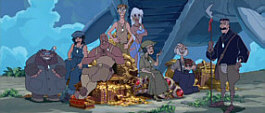 During some of the extras, the filmmakers discuss the backstory for the Shepherd’s Journal and its history. More information about the life and times of this fictional book appears in “History of the Shepherd’s Journal”, a text extra that includes a very interesting and detailed look at what happened to the book over the centuries. “The Shepherd’s Journal” offers stillframe glimpses of the pages actually seen in the movie, while “Shepherd’s Journal Designs” features 31 thumbnailed stills of drawings created to inspire the materials included in the tome.
During some of the extras, the filmmakers discuss the backstory for the Shepherd’s Journal and its history. More information about the life and times of this fictional book appears in “History of the Shepherd’s Journal”, a text extra that includes a very interesting and detailed look at what happened to the book over the centuries. “The Shepherd’s Journal” offers stillframe glimpses of the pages actually seen in the movie, while “Shepherd’s Journal Designs” features 31 thumbnailed stills of drawings created to inspire the materials included in the tome.
History ends with *”How to Speak Atlantean”. A cutesy fake instructional film, this two-minute and 15-second piece features Marc Okrand, the guy who invented the language for the flick. It’s pleasant enough but not something I’d care to watch again.
Next we move to Story and Editorial, which begins with another segment from the documentary. “Finding the Story” lasts 11 minutes and 20 seconds as it provides remarks from Hahn, Trousdale, Wise, artistic supervisor of story John Sanford, Ellen Keneshea, and Tab Murphy. This piece offers a very good look at the story development as the participants relate the ways in which it grew and changed. We hear about an early pirate theme as well as lava whales and other elements that didn’t make the final cut. It’s a terrific program.
Four “Deleted Scenes” appear after this. Most animated movies don’t have any fully realized unused material. The process is so expensive that the filmmakers use storyboards and the planning process to weed out any potential problems before they’re animated. However, every once in a while, one slips through and gets cut at the last minute. For Atlantis, *”The Viking Prologue” fell into that category. Presented anamorphically-enhanced 2.35:1 with Dolby Digital 5.1 sound, the two-minute segment looks totally finished and could slip right into the end product. It’s a good scene that would have worked fine in the movie, but when you learn the filmmakers’ reasons for replacing it, you’ll understand why it didn’t survive.
The three other deleted scenes found on the DVD didn’t get so far in production. Presented as storyreels - filmed storyboards accompanied by sound - we see “The Squid Bats” (6:27), “The Lava Whales” (3:40) and “The Land Beast” (4:28). I’d guess the last too went farther than the first. Both include somewhat better artwork and mainly the voices of the real actors, while “Bats” offers temp voices. Ironically, I thought “Bats” was the best of the bunch; it’s the only one I think would have been fun to see in the movie. However, all of them add to what the filmmakers refer to as the “monster parade”, so I understand their deletion.
 This domain ends with “Original Treatment”. This stillframe section combines text with conceptual art to show an early draft of the story. Though some alterations exist, I’m surprised at how close the final result hews to the treatment; I expected more changes. Anyway, it’s a cool look at the first basic version of the tale.
This domain ends with “Original Treatment”. This stillframe section combines text with conceptual art to show an early draft of the story. Though some alterations exist, I’m surprised at how close the final result hews to the treatment; I expected more changes. Anyway, it’s a cool look at the first basic version of the tale.
Many more drawings appear in Art Direction. This area kicks off with “Designing Atlantis”, another component of the documentary. This 11-minute and 20-second piece includes comments from Hahn, Wise, Trousdale, Dave Goetz, production designer Mike Mignola, Lisa Keene, Chris Jenkins, and president of Walt Disney Feature Animation Thomas Schumacher. It’s a solid compendium of information about the visual design of the movie. We learn of Mignola’s stylistic influence as well as research and a mix of other concerns in this informative and useful program.
From there we find lots of galleries. Seven of these cover various locations, while the eighth offers “Mike Mignola designs”. Thumbnailed as usual, each includes between eight and 76 images for a total of 296 shots. Mostly we find fairly lush conceptual art, along with some more rudimentary planning drawings. This kind of section exists for the hard-core fans who want to see everything, and it should make them happy.
The “Art Direction Style Guide” offers one of the coolest stillframe galleries I’ve witnessed. This packet is discussed in the documentary, so it’s great to see more of it here. Essentially, the 38-image thumbnailed gallery shows the decisions made for the look of the film as they’re spelled out for the artists. We find discussions of the architectural styles desired - “no Greek or Roman!” - plus an excellent deconstruction of Mignola’s look and other elements. It’s an absolutely fascinating view of the details behind the production process.
Within Animation Production, we find an even greater level of detail. This area starts with three sections of the documentary. “The Voices of Atlantis” looks at the actors. In the 12-minute segment, we hear from Hahn, Trousdale, Wise, John Pomeroy, supervising animator for “Kida” Randy Haycock, supervising animator for “King Nekadh” Michael Cedeno, supervising animator for “Rourke” Mike Surrey, supervising animator for “Vinny” Russ Edmonds, supervising animator for “Sweet” Ron Husband, supervising animator for “Cookie” Shawn Keller, and actors Michael J. Fox, Cree Summer, John Mahoney, James Garner, Jacqueline Obradors, Corey Burton, Don Novello, Phil Morris, Florence Stanley and Claudia Christian.
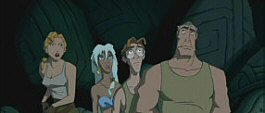 Whew - with such a substantial crew of participants, you might expect a substantial discussion. Unfortunately, “Voices” offers the weakest link in the documentary. While it includes some decent shots of the actors at work, for the most part it provides something of a puff piece. We hear how great everyone is and how much fun it was, but little substantial information escapes. It remains watchable but it seems disappointing, especially since most of the other documentary segments are so good.
Whew - with such a substantial crew of participants, you might expect a substantial discussion. Unfortunately, “Voices” offers the weakest link in the documentary. While it includes some decent shots of the actors at work, for the most part it provides something of a puff piece. We hear how great everyone is and how much fun it was, but little substantial information escapes. It remains watchable but it seems disappointing, especially since most of the other documentary segments are so good.
Much better is “Creating the Characters”. The longest component, this one lasts 26 minutes and 15 seconds as it provides remarks from Hahn, Wise, Tab Murphy, Michael Cedeno, supervising animator for “Moliere” Anthony De Rosa, John Pomeroy, artistic supervisor of cleanup Marshall Toomey, Ron Husband, Mike Surrey, Randy Haycock, Russ Edmonds, supervising animator for “Helga” Yoshimischi Tamura, supervising animator for “Audrey” Anne Marie Bardwell, supervising animator for “Mrs. Packard” Dave Pruiksma, and Shawn Keller.
Overall, this piece offers a terrific look inside the mind of the animator. It provides one of the best discussions of their form of acting, as we learn more about how they get inside the characters and really emote via their pencils. It gives us a fine glimpse of the depth of this process and I really enjoyed it; this is one of the better parts of a generally excellent documentary.
Another segment examines another part of the animation experience. “Setting the Scene” goes for 12 minutes and 15 seconds as it includes statements from Hahn, Ed Ghertner, Chris Jenkins, Wise, Trousdale, Lisa Keene, Marlon West, and Thomas Baker. It splits into a few different areas: layout, background, effects animation, and scene planning. This program seems a little drier than many of the others, but it still offers good information on the subject. Best of the bunch are notes about Keene’s research and planning as well as the multiplane images featured in the film.
From there we encounter scads of stillframe materials. The “Color Script Gallery” includes 59 images used to denote the appropriate tones for various settings in the film, while “Layouts and Backgrounds” provides 141 examples of those elements. As with some of the other pieces found on the disc, these remain of interest mainly to the biggest fans, but they’re still nice to have.
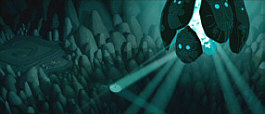 Next we go to examinations of the various characters. Most of these areas include similar features. All of the sections feature stillframe galleries of conceptual art. There are 14 of these domains in all, and they offer between 14 (Mrs. Packard) and 191 (Miscellaneous Characters) images for a total of 842 pictures. Most of these depict conceptual art created to come up with the ultimate designs, but we also see images of character reference sheets used to make sure the various animators kept things consistent. These are quite interesting to see; unlike items such as color scripts, these should appeal to even more lukewarm fans.
Next we go to examinations of the various characters. Most of these areas include similar features. All of the sections feature stillframe galleries of conceptual art. There are 14 of these domains in all, and they offer between 14 (Mrs. Packard) and 191 (Miscellaneous Characters) images for a total of 842 pictures. Most of these depict conceptual art created to come up with the ultimate designs, but we also see images of character reference sheets used to make sure the various animators kept things consistent. These are quite interesting to see; unlike items such as color scripts, these should appeal to even more lukewarm fans.
For eight of the members of the Whitmore expedition - Milo, Rourke, Sweet, Helga, Audrey, Packard and Moliere - we also find animation tests and “dossier files”. Kida’s area provides animation tests but no dossier, while Vinny’s area includes a dossier but no animation test. The other four - Preston Whitmore, Miscellaneous Characters, King Nedakh, and Miscellaneous Atlanteans - just include the “design” galleries mentioned above. The dossiers are a lot of fun. These provide text biographies of the various characters. Just like the material about the Shepherd’s Journal, these are surprisingly detailed, and they add some nice depth to the package.
As for the animation tests, they each last between 12 seconds and 44 seconds for a total of 220 seconds of footage. Mainly these consist of rough pencil animation, and they’re worth a look mainly to hear some temp voice acting during a few of them. Milo’s section also includes a “Production Progression”. This lets you use your “angle” button to jump from rough animation to cleanup animation to final color for one 24-second scene. It’s a nice little feature but nothing terrific.
That finally concludes the “Animation Production” domain; now we move to Digital Production. This starts with a documentary segment also titled “Digital Production”. The 10-minute and 15-second program includes comments from Hahn, Wise, Trousdale, artistic supervisor computer graphics imagery Kiran Joshi, supervising animator “leviathan” Mike Merell, Marlon West, Ed Ghertner, Lisa Keene, Chris Jenkins and Dave Goetz. It’s another good piece, as we learn nice details about the manner in which 3D elements blended with their 2D counterparts. Disney animators have used computer technology since the Eighties, while the CAPS system launched in 1990; this is possibly the clearest and most sensible explanation I’ve heard about the various techniques.
In “Digital Production Tests”, we find something a little different from the other documentary segments. This six-minute and 20-second clip simply shows a variety of early animation works that are narrated by Wise. He describes what they tried to do and where the techniques went. It’s a good complement to the prior program, and it was also fun to see the Disney character they used for the digital tattoo tests!
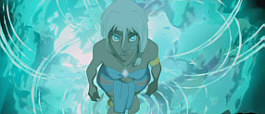 This area includes a wealth of additional still galleries as well. Under the heading of “Vehicles” we discover 11 crafts found in the film. These areas provide between 4 and 87 pictures for a total of 278 images. I didn’t think these were as interesting as the character drawings, but more interested fans will enjoy them.
This area includes a wealth of additional still galleries as well. Under the heading of “Vehicles” we discover 11 crafts found in the film. These areas provide between 4 and 87 pictures for a total of 278 images. I didn’t think these were as interesting as the character drawings, but more interested fans will enjoy them.
All of the 11 vehicles also includes “Turnarounds”. These show digital images that spin around the craft. The segments last between 19 seconds and 143 seconds for a total of 12 minutes and 58 seconds of footage. Frankly, I think these features are a little monotonous, but they do offer more depth, so I appreciate their inclusion.
A bit more interesting is the “Progression” provided for the Ulysses. This 40-second clip shows the various stages of completion for the craft. As such, it’s moderately watchable. We also get a “Vehicle Size Comparison”. This simply offers a 42-second clip that goes from smallest to largest to give us some scope.
The final sections of the “Digital Production” domain cover computer-created “Characters”. This includes stills for the Leviathan (17 images) and the Stone Giants (24 frames). Those two also provide “Turnarounds” that last 125 seconds and 28 seconds, respectively. The “Digital Extras” domain simply shows more “Turnarounds” of a variety of small characters; this segment goes for 98 seconds. (Note that the single-disc Atlantis lists “virtual tours of CG models - Ulysses and Leviathan” among its features. I’d feel shocked if those didn’t replicate materials I just described, but I couldn’t identify the specifics, so I didn’t include the asterisk to denote shared extras. Nonetheless, I’m sure that whatever is on the basic DVD also appears here.)
With that we leave “Digital Production” and move to Music and Sound. This section consists solely of a nine-minute documentary slice that includes statements from Hahn, sound designer Gary Rydstrom, editor Ellen Keneshea, executive Thomas Schumacher, and composer James Newton Howard. The parts that relate to sound design are a little general but fairly compelling, as they cover the various challenges caused by animation since literally all of the audio must come from a secondary source; with no set on which to shoot, there can be no natural sound. The discussion of the music is less useful, as it seems somewhat puffy and uninformative.
Within the Publicity we find four trailers as well as the film’s “Print Campaign”. This provides another thumbnailed gallery with 17 images. After that, the disc finally concludes with Atlantis Found, the last chapter of the documentary. This seven-minute and 40-second piece offers a valedictory look at the movie as we watch some footage of the flick’s premiere and also hear interviews with Hahn, Trousdale, Wise, Mike Mignola, Lisa Keene, Marlon West, Kiran Joshi, Thomas Baker, Chris Jenkins, Marshall Toomey, Tab Murphy, and John Pomeroy. It isn’t terribly informative and doesn’t work very well on its own; it really exists as an ending for the documentary. In that regard, it functions nicely; it’s a bit puffy, but it ends the package on the appropriate note.
 If you’re looking for a classic Disney animated film, Atlantis: The Lost Empire won’t deliver the goods. It’s a more-than-competent piece that offers a reasonably enjoyable and entertaining experience, but it doesn’t stand as one of the studio’s best works. Still, it’s a good flick that remains above average when compared to cinema in general.
If you’re looking for a classic Disney animated film, Atlantis: The Lost Empire won’t deliver the goods. It’s a more-than-competent piece that offers a reasonably enjoyable and entertaining experience, but it doesn’t stand as one of the studio’s best works. Still, it’s a good flick that remains above average when compared to cinema in general.
As for the DVD, it’s an absolutely stellar product. Both picture and sound quality maintain the exceedingly high standards of other fresh-from-the-theater Disney films; I’ve come to expect excellent reproduction of the movie, and Atlantis didn’t disappoint me. In regard to the extras, this may well be the best-executed DVD I’ve ever seen. I won’t say that it’s the most comprehensive, for that’s a tough call to make. However, it’s up there with the deepest packages, as it leaves virtually no stones unturned.
Where Atlantis breaks from the pack relates to the breadth of the materials. Virtually all two-disc Disney releases include extensive still galleries and archival materials, and they also toss in audio commentaries. Atlantis improves upon the latter model with some useful video components as well.
However, as fun as the video commentary was, the thing that makes Atlantis unique among other Disney DVDs is its documentary. Many prior packages offered lots of small video tidbits, and even when they attempted to connect them together - as with The Emperor’s New Groove - they remained fairly brief compendiums. Atlantis offers a documentary that lasts almost two hours, and it’s a rich, detailed piece of work.
Excuse me if I seem to gush over these extras, but it’s not often I find such a substantial package. Add to this the user-friendliness offered by a mix of interactive options and you have a truly special piece of work. I’ve seen many excellent Disney releases, but with its combination of elements that will greatly appeal to casual fans and diehards, Atlantis is the best of the bunch and also one of the finest DVDs I’ve ever seen.



